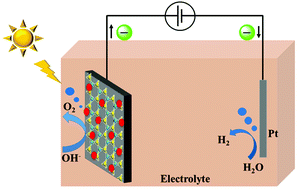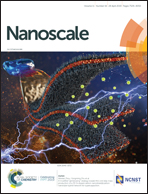Ultrathin MoS2 nanosheets for high-performance photoelectrochemical applications via plasmonic coupling with Au nanocrystals†
Abstract
In this work, we prepared ultrathin MoS2 nanosheets with exposed active edge sites and high electric conductivity that can sufficiently absorb light in the visible region to enable solar energy conversion. The gold nanocrystal–decorated MoS2 nanosheets facilitate sufficiently enhanced photoelectrochemical water splitting in the UV–visible region. Different Au nanostructures, such as Au nanoparticles and nanorods, were modified on the surface of MoS2 nanosheets to promote photoelectrochemical water decomposition. By spin-coating a synthetic gold–modified MoS2 hybrid photoanode on a FTO substrate, the efficiency of photoelectrochemical water oxidation was significantly enhanced, by 2 times (nanorods) and 3.5 times (nanoparticles) in the visible–infrared region; furthermore, the average optical resistance was reduced by a factor of two compared to the MoS2 photoanode without Au, and the photocurrent increases exponentially when the system bias was greater than 0.7 volts. The Au–MoS2 metal–semiconductor interface plays an important role in studying the surface plasmon interactions, charge transfer mechanism, and electric field amplification. This rational design for such a unique hybrid nanostructure explains the plasmon-enhanced photoelectrochemical water splitting. This current contribution provides a new path for using the plasmonic metal/semiconductor heterostructure to effectively harvest UV–visible light for solar fuel generation.



 Please wait while we load your content...
Please wait while we load your content...